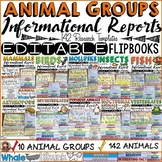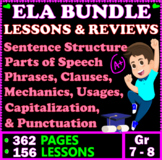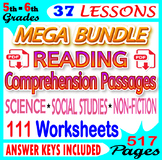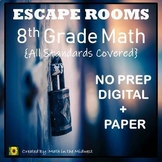52 results
8th grade oral communication chemistry resources for Montessori
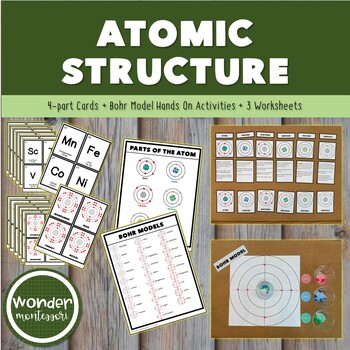
Atomic Structure Montessori Cards, Bohr Model, and Activities
Atomic Structure Montessori Cards, Bohr Model, and ActivitiesLooking for a great way to bring together art and ELA in your classroom? This DIY postcard set is a quick and easy eay to accomplish that. Just print, cut, and go!This download includes a huge assortment of activities for Upper Elementary aged students. These can be done as lessons, or students may work through on their own or in small groups.- 4-part cards address parts of an atom: proton, neutron, electron, nucleus, orbital, and a
Subjects:
Grades:
4th - 8th
Types:
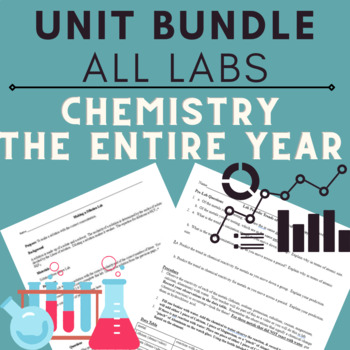
BUNDLE: High School Chemistry Labs -- THE ENTIRE YEAR for Every Unit (41 Labs!!)
Outline of each Unit to Lab Match:Introduction: Scientific Method LabIntroduction: Accuracy and Precision LabConversions: Converting Everyday Objects.Conversions: Conversion Version 2 - Using your own conversion factors.Matter & Changes: Density LabMatter & Changes: Mixture Separation Chromatography LabMatter & Changes: Physical and chemical Changes LabThe Atom: Isotope Activity/LabThe Atom: How Thick is Aluminum Foil? LabThe Atom: Online Atom Builder LabNuclear: Iodine Clock for Dec
Subjects:
Grades:
8th - 12th, Higher Education
Types:

Molecule model 3 part cards
Montessori 3 part cards to support the universe curriculum i.e Bohr's board.
Subjects:
Grades:
2nd - 8th
Types:
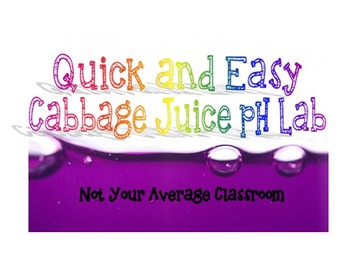
Quick and Easy Cabbage Juice pH Indicator Lab
This activity results in impressive color changes and is really fun to do! Students will use cabbage juice to test various substances for acidity or alkalinity. Purple cabbage juice turns bright pink for acids and bright blue for bases. This lab lists vinegar, tap water, baking soda solution, lemon/lime soda, and bleach solution - but you can easily convert the file to a word document and edit as needed.
This is a completely qualitative lab, and it is meant to be done in very little time. The ac
Subjects:
Grades:
5th - 12th
Types:

Hands-on Interactive Volcano Bundle Study: Types, Formation and Famous Volcanos
Create a science experiment of a real "erupting" volcano with a 3D model and step by step instructions. Learn about how volcanos form with a illustrated poster and learn about volcanos around the world with full color cards.*Photos may include completed items or display items not included. Please note this is ONLY for the digital copies of the resources used.
Subjects:
Grades:
PreK - 8th
Types:

LAB Chemistry Density of Pennies - with Graphing & Demos
Engage your chemistry students by having them determine the composition of pennies as it changed over time. Students will chart & graph their results. After, you can demonstrate and prove that pennies are made of zinc internally.Included:3 page Student worksheet with procedure, chart, graph & analysis questions1 page teacher density demonstrations (5 easy options)Materials: pennies 13 pre 1982 & 13 post 1982 (per group or 1 set every two groups & switch pennies)graduated cylinder
Subjects:
Grades:
4th - 12th, Higher Education
Types:
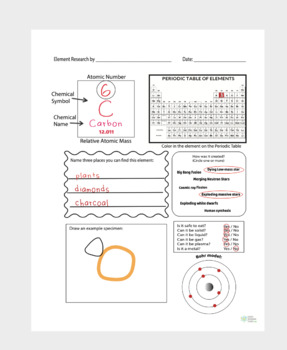
Element Research Portfolio
Everything your students need to make research portfolios all about the elements. Includes a cover page to decorate and a double-sided worksheet to guide research (I listed our favorite books and free websites) as well as a periodic table that shows where the elements come from to make completion simple and straight-forward. Use the included blue-lined, Montessori style paper to write favorite facts (or use your own paper style if preferred). Makes for wonderful student-lead learning & Mont
Subjects:
Grades:
1st - 9th
Types:
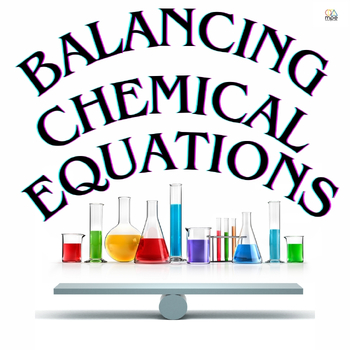
Balancing Chemical Equations
Introduction: Balancing chemical equations is a crucial skill in chemistry that involves adjusting the coefficients of reactants and products in a chemical equation to ensure that the number of atoms of each element on both sides of the equation is equal. This process is essential in understanding chemical reactions and predicting the outcome of a reaction. Balancing chemical equations is also helpful in real-life scenarios, such as industrial processes involving chemical reactions or environmen
Subjects:
Grades:
5th - 8th
Types:
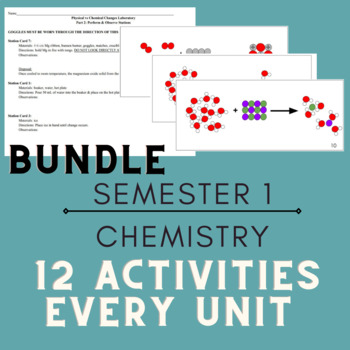
BUNDLE: High School Chemistry Semester 1 Activities (Every Unit- 12 Activities!)
Outline of each Unit to Activity Match:*computers Required for 4 activities!!*Introduction: Equipment IdentificationMatter & Changes: Tricky Mixtures StationsMatter & Changes: Physical vs Chemical Particle Diagram Identification x 2The Atom: Online Atom Builder Nuclear/Radioactivity: 1 Day Poster Research ProjectElectrons: Bohr Models & Electron Configuration RelationshipsElectrons: BattleshipPeriodic Table: Coloring Groups/FamiliesChemical Bonding: Building Molecules with Model Kits
Subjects:
Grades:
8th - 12th, Higher Education
Types:
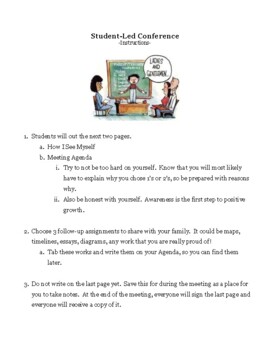
Student-Led Conference
Use these forms to help your students to independently prepare for a student-led conference. Included is an instructional page, a self assessment, a meeting agenda template, and a page to take notes and sign to verify attendance of the meeting.
Subjects:
Grades:
3rd - 12th
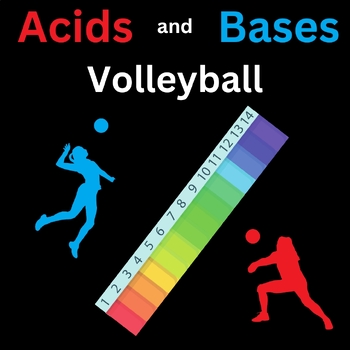
Acids and Bases Volleyball
What makes something acidic or basic? It all comes down to hydrogen. When we measure the acidity of alkalinity, we use the pH scale, which literally stands for the "potential of hydrogen." When we dissolve acids in water, we create excess hydrogen ions that are positively charged (H+). These hydrogen ions bind to water (H2O) to create hydronium (H3O+). The more hydronium present in the solution, the more acidic it is. Conversely, when we dissolve bases in water, we create excess negatively char
Subjects:
Grades:
5th - 8th
Types:
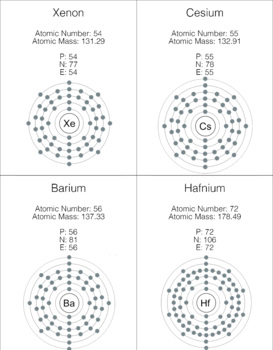
Elements of the Periodic Table Electron Orbitals
Element cards with electron orbitals, number of protons, neutrons, and electrons, name of elements, and element symbol. Use these cards to further explore atoms, subatomic particles, and elements of the periodic table.These are not three part cards, but can easily be made into three part cards by cutting the name off the top.
Subjects:
Grades:
1st - 10th
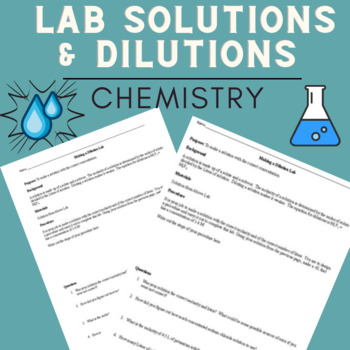
LAB - Chemistry - Make a Solution & Dilution - Easy Materials! - With KEY
This lab has students write their own procedure to make a solution and dilution with teacher observation & testing. This inquiry-STEM activity is great to get students thinking and engaged. Even some of the smartest students fail to connect Molarity to physical performance. This lab allows for that connection.I usually use a pH strip to test their solutions and dilutions! pH probe is better as well.materials:solute - the KEY is with citric acid, but any can be used.BalanceGraduated Cylinderb
Subjects:
Grades:
8th - 11th
Types:
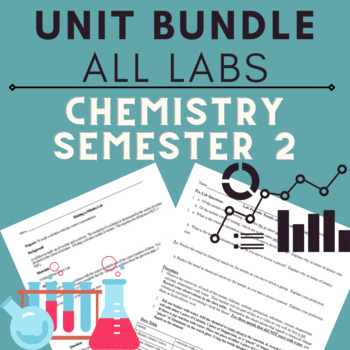
BUNDLE: High School Chemistry Semester 2 Labs; Labs for Every Unit (20 Labs!!)
Outline of each Unit to Lab Match:Moles: Chalk Name & Body LabMoles: Molar Volume ConversionStoichiometry: Decomposition of Baking Soda LabLimiting Reactants: Limiting Reactant LabGases: 8 Stations Gas LawsGases: Exploring Variable Relationships (online)Gases: DiffusionGases: Gas Stoichiometry DesignSolutions: Properties of WaterSolutions: Calculate MolaritySolutions: Make a Solution & DilutionSolutions: Make Ice CreamAcids & Bases: pH of common materialsAcids & Bases: Mini Soda
Subjects:
Grades:
8th - 12th, Higher Education
Types:

LAB Chemistry - Nuclear Decay - Wet Lab
Engage your chemistry students by having them performing an iodine clock reaction -- reimaged to be assigned to nuclear decay! Students will time the clock, graph the results and imagine how the nucleus decays over time.Included:1 sheet Lab 2 pages1 Sheet teacher solution creation directionsObjective: Observe and determine the equilibrium shift of the reactionMaterials Students:• Solution A• Solution B• 2 Erlenmeyer flasks• 3 graduated cylinders • A magnetic stirrer (if available) Timer• Beaker•
Subjects:
Grades:
8th - 12th, Higher Education
Types:
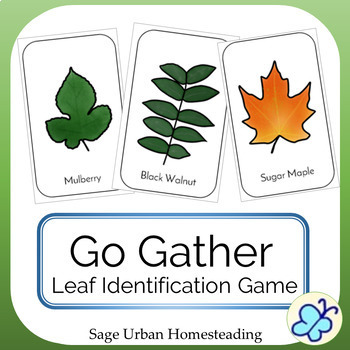
Go Gather Leaf Identification Game
Do you wish you could easily identify all of those leaves you collect on nature walks?Here is a "Go Fish" style game for learning leaf identification for 12 common and useful trees that grow in the eastern United States. There are a variety of card decks included: summer colors, autumn colors, and blank outlines. The decks are also available with or without labels.The trees included are basswood, black oak, black walnut, mulberry, pawpaw, persimmon, redbud, river birch, sassafras, sugar maple, s

LAB Chemistry - Equilibrium Le Chatlier's Principle
Engage your chemistry students by having them performing an equilibrium shift. This lab is empowering because students can SEE the shift right before their eyes. This lab does require quite a bit of set up, but is well worth the effort.Included:1 sheet Lab 2 pagesObjective: Observe and determine the equilibrium shift of the reactionMaterials test tube tongs droppers0.1 M &g Iron (III) Nitrate 0.1 M KSCN 0.1 M NaOH 0.1 M Silver Nitrate 0.5 g KClWater 7 Test Tubes Test Tube Rack Stirring Ro
Subjects:
Grades:
8th - 12th, Higher Education
Types:
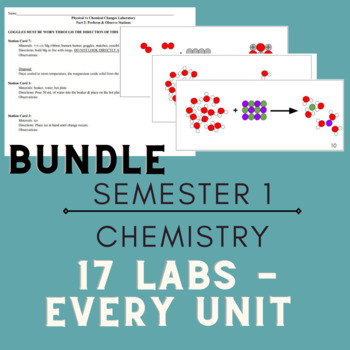
BUNDLE: High School Chemistry Semester 1 Labs; Labs for Every Unit (22 Labs)
Outline of each Unit to Lab Match:Introduction: Scientific Method LabIntroduction: Accuracy and Precision LabConversions: Converting Everyday Objects.Conversions: Conversion Version 2 - Using your own conversion factors.Matter & Changes: Density LabMatter & Changes: Mixture Chromatography LabMatter & Changes: Physical and chemical Changes LabThe Atom: Isotope Activity/LabThe Atom: How Thick is Aluminum Foil? LabThe Atom: Online Atom Builder LabNuclear: Iodine Clock for Decay LabElect
Subjects:
Grades:
8th - 12th, Higher Education
Types:

Parts of a Plant Cell 3 Part Cards Montessori Nomenclature Botany
Montessori's Classified Cards are well-known and loved because they are a great way to help your child learn to read. This resource is included in Zoology Unit 1: Basic Introduction to Living Organisms - click here for that resource.⭐⭐⭐3-Part Cards Parts of a Plant Cell Montessori⭐⭐⭐Save yourself hours of work. All you have to do is download the PDF, cut out the cards and labels, and you are all ready to go! The following is included:16 pictures with labels in type font (approximately 3½ x 3¼) 1
Grades:
1st - 9th
NGSS:
MS-LS1-2
Also included in: Living Nonliving Bundle eLearning and Printables Montessori Zoology
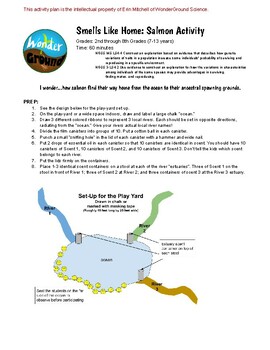
Salmon: Smells Like Home
Another engaging activity by WonderGround Science! In this activity, students will become anadromous fish, navigating their way to their ancestral spawning grounds. The activity includes 7 deep-thinking questions for students to discuss, regarding water quality, turbidity, and other factors that might hinder chemical cues that salmon use to navigate. Materials are found in a typical classroom.
Subjects:
Grades:
2nd - 8th
Types:
NGSS:
3-LS4-3
, 3-LS4-2
, 3-LS4-4
, MS-LS4-4

Clothing and Colors Ropa y Colores Game
Boring drills and worksheets are not the best way to review vocabulary and practice noun-adjective agreement. Learning how to speak a language comes from engaging situations where students actually need to use it to communicate. That's why games are great!
Here is a "Go Fish" style game for learning clothing and colors. There are over 20 vocabulary words related to different types of clothing. Please see the preview for the complete list.
There are card decks included with Spanish labels, Eng
Subjects:
Grades:
K - 9th
Types:
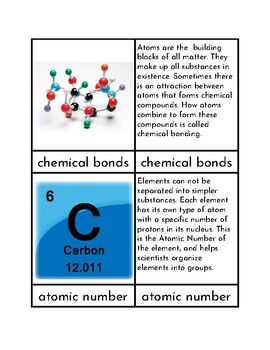
Chemical Bonds - Three/Four Part Cards
This PDF can be used to create a set of three or four part cards to teach children about basic Chemical Bonds. There is a picture card, word card, a picture and word card (control), and description card for each of the following terms: chemical bonds, atomic number, electron shells, outer shells, valence electrons, covalent bonds, and ionic bonds. Be sure to check out my FREEBIE: Parts of an Atom - Three/Four Part Cards!! Cards should be printed onto card stock, cut, and laminated.
Subjects:
Grades:
3rd - 8th
Types:
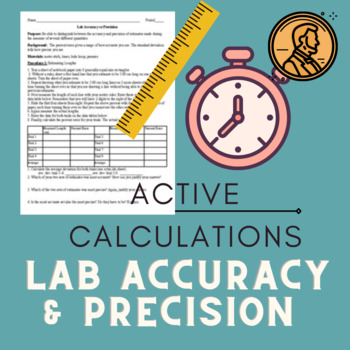
LAB Accuracy and Precision - Kinesthetic, Engaging, and Calculation Practice
Time: 50 minutesMaterials: Rulers, timers/stopwatches/computer for stopwatch, Pennies, & A target (hula hoop, tape on the floor)
Subjects:
Grades:
8th - 11th
Types:
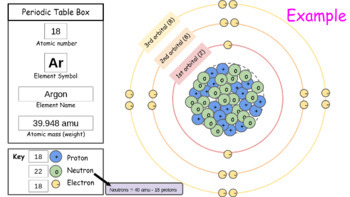
Challenge: Model an Atom from the Periodic Table (Classroom or Remote Learning)
Assign a copy of this google slide show to students. They can work alone, in pairs, or small groups. Challenge students to model an atom of more than one element. Copy and paste the key symbols to create an atom model. Students will use their knowledge of the periodic table to figure out the correct amount of protons, neutrons, and electrons for an atom of their choice. If you want students to model multiple elements, then simply copy and paste the blank template a few more times before assignin
Subjects:
Grades:
6th - 10th
Types:
NGSS:
HS-PS1-1
, MS-PS1-1
Showing 1-24 of 52 results




